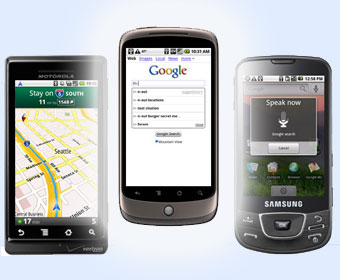The much discussed ‘Google phone’ became a commercial reality at the beginning of the year, when the web giant unveiled the first of its own-brand devices – the Nexus One. The announcement raised a number of eyebrows and even more questions.
February 1, 2010

The much discussed ‘Google phone’ became a commercial reality at the beginning of the year, when the web giant unveiled the first of its own-brand devices – the Nexus One. The announcement raised a number of eyebrows and even more questions.
Traditional handset vendors got no let-up from the sector’s upstarts in the opening days of 2010. Before Apple had introduced us to a niche within a niche with its iPad as January drew to a close, internet heavyweight Google had thrown its hat into the ring with the launch of the Nexus One. This, the firm promised, would be the first of many Google-branded handsets, the arrival of which had been mooted since the firm bought Android in 2005.
Until January, Google had seemed content to let its handset manufacturing partners shoulder the developmental burden, relying on competition between them to generate to drive the most innovation from the Android platform. There were at least 20 Android handsets in the market at the close of 2009 and that number is likely to more than double in 2010. Perhaps Google was disappointed with the progress its partners had made, though.
The argument that pitches open source competition against a closed dictatorship will probably never be satisfactorily answered. But given that Google’s play with Android is all about driving more people to Google’s ever-expanding suite of internet based services and applications, it is perhaps not surprising that the firm should look to exert a little more control than it was able to muster by simply lobbing a new OS into the development arena.
Manufactured by HTC, the Nexus One features a 3.7″ OLED display, five megapixel camera and a 1GHz Qualcomm Snapdragon chipset. It runs on Android 2.1, the newest version of Eclair, and boasts features like a voice-enabled ‘keyboard’ allowing users to speak into any text field. It also comes with a host of popular Google applications, including Gmail, Google Voice and Google Maps Navigation.
“Google sees these devices as a means to an end. And that end is to build a large user base for Google’s mobile services; to expose that user base to advertising; and to collect the data its user base generates…”
IDC’s research director John Delaney described the Nexus One as “the best Android phone to hit the market so far,” so perhaps the firm has achieved its goal in that respect. But the price of the unit, and the choice of sales channel, have been set in a way that might not necessarily encourage uptake in huge volumes. It was thought that perhaps Google would try and undercut Apple with its pricing, but that was not the case.
On its own, the phone retails for $529, which drops to $179 with a T-Mobile USA Even More plan, which starts at $39.99 per month. But the only place to buy the phone, either unlocked or on the T-Mobile network, is from the online Google store. Interested parties cannot get the handset from T-Mobile, which means that it cannot be sold as an upgrade to existing customers. Nevertheless, the operators seem to be on board. Google has promised partnerships with Verizon Wireless in the US and Vodafone in Europe in the near future.
So why is Google entering the phone business so directly at all? Delaney believes that Google sees these devices as a means to an end. And that end is to build a large user base for Google’s mobile services; to expose that user base to advertising; and to collect the data its user base generates. “In other words, Google wants to be everyone’s starting point when they use the mobile internet,” Delaney said.
The reality, however, may turn out different to the ambition. Google won’t be launching its own-brand Android devices into the vast and fast growing Chinese market. Indeed, the web services firm is threatening to pull its local search engine amid censorship concerns and allegations that Chinese hackers broke into Google’s email services and gained access to the email accounts of Chinese human rights activists.
Yet Android will find its way into the Chinese market by another route. Resurgent US vendor Motorola will launch its recently unveiled MotoRoi Android-based device in China via China Unicom and will also release OPhone devices based on China Mobile’s own Android-based platform.
The home grown OPhone open source platform is really just another branch of the Android operating system. The OPhone SDK 1.5 is compatible with Android SDK 1.5, so developers can use both OPhone APIs and Android APIs to develop OPhone applications.
To accompany the launch of the MotoRoi, Motorola recently opened the doors of its Android focused app store in China. The Shop4Apps, or Zhi-Jian-Yuan, which means “Place for Apps Wisdom” in Chinese, will allow users to download apps and customise their Android-based handsets with new services including a search provider of their own choice. The search providers available are the government sanctioned local providers like Baidu, and are likely exclude the likes of Google.
Motorola said Shop4Apps will give developers a path to promote their applications in the market through MotoDev, Motorola’s global developer program, and through other Android development ecosystems like OPhone.
Read more about:
DiscussionAbout the Author(s)
You May Also Like








.png?width=300&auto=webp&quality=80&disable=upscale)


_1.jpg?width=300&auto=webp&quality=80&disable=upscale)


.png?width=800&auto=webp&quality=80&disable=upscale)